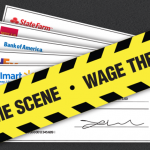Following countless exposés revealing the dangers of working at Amazon, Jobs With Justice and Amazon workers uplift today’s federal action, where Senators finally propose new laws to protect Amazon worker safety.
Washington — Jobs With Justice, in collaboration with the Athena Coalition and workers at Warehouse Life, welcomes today’s introduction of the critically important Warehouse Worker Protection Act (WWPA) — a highly anticipated federal action that would protect workers and support organizing efforts amidst the warehouse worker injury crisis driven by Amazon’s relentless pursuit of speed.
“This bill is a direct response to the urgent need to address the safety crisis exacerbated by Amazon’s practices,” says Olivia Bradley, Warehouse Life Organizer and Former Amazon Worker. “Workers injured at Amazon are the driving force behind this effort, and we stand in solidarity with them in demanding meaningful change.”
Today, Sens. Ed Markey and Tina Smith introduced the WWPA aimed at safeguarding warehouse workers, drivers, and subcontractors. This federal legislation builds on the groundwork of statewide initiatives in New York, California, Minnesota, and Washington and directly responds to the challenges highlighted by Amazon’s worker safety crisis.
“Federal action, in response to the Amazon injury crisis, is necessary to protect workers trying to organize,” said Sofia Solano, Interim Executive Director, Colorado Jobs with Justice. “Incredibly, workers have been able to organize in some places, even as they face injuries that too often force them to turn over at rapid rates. This bill is vital for Amazon workers to fully exercise their right to organize and start holding Amazon accountable.”
The alarming findings of the NELP report released today reveal high injury rates among Amazon workers and underscore the urgency of federal intervention. Despite Amazon’s claims of prioritizing safety, evidence suggests a pattern of underreporting injuries and willful violations of safety regulations.
According to the NELP report, Amazon surpasses all other warehouse employers in workforce size, reporting seven times the number of warehouse employees as the next largest warehouse employer, Walmart. Amazon also operates more facilities than any other single company, with a total of 418 general warehousing and storage facilities across the country.
Amazon tries to hide behind a smile on every package, but when we look closely, we see that injuries at Amazon warehouses are substantially higher than at comparable U.S. warehouse employers—with Amazon’s injury rate almost tripling Walmart’s. Moreover, injuries at Amazon warehouses are much more likely to be serious enough to require time off work or job transfer than at other comparable warehouse employers.
Sury Legulsamon, former NJ Amazon worker, recounted how lack of transparency on rate quotas, coupled management oversight, resulted in her termination for low productivity: “In March, I was fired after working at Amazon for two years. I was an extremely hard worker and was trained to do almost every role in my facility. Because of that, managers would move me from area to area in our huge building — which would make my ‘productivity rate’ drop through no fault of my own. Amazon is supposed to account for that and I even followed up with my manager to ask about it and they said they were. But it turns out that never happened and the system was giving me automatic write-ups all along — which I was never told about. If the Warehouse Worker Protection Act had existed, I never would have been fired.”
Lisa, a current NJ Amazon worker, spoke about her lifetime injury acquired on the job: “I’ve been a full-time Amazon associate for six years, and I’ve seen my fair share of challenges on the job. Last year, while handling heavy items as part of my duties, I suffered a debilitating injury to my back and foot. Despite reporting the incident to AmCare and receiving minimal treatment, the pain persisted. The pain traveling down both my legs was overwhelming but I was unable to locate a manager to report my injury. I left work early, only to find myself immobilized the next day. When I reached out to HR, I was shocked to hear from them that I wasn’t eligible for workers’ compensation due to not reporting the injury to a manager at that moment. Now, I’m grappling with a diagnosis of spinal stenosis. The excruciating back pain I endure daily serves as a constant reminder of the lasting impact this injury may have on my life. Congress needs to pass legislation to protect future workers so no one has to go through what I’m suffering.”
Federal legislation is not only crucial for ensuring the safety and well-being of warehouse workers but also for safeguarding their right to organize and advocate for better working conditions. The proposed bill includes provisions to empower workers by providing transparency in regards to quotas, restricting punitive practices, and establishing meaningful enforcement mechanisms.
“I worked at Amazon four years ago and have been working to organize Amazon workers ever since.” stated Jessica Sanchez, former Amazon employee and current Colorado-based organizer. “It’s impossible to create momentum when the average worker lasts less than a year. Many workers leave due to preventable injuries.”
Notably, section 201 is focused on the National Labor Relations Act and would specifically prohibit the use of quotas to interfere with workers’ ability to exercise their right to organize.
Amazon, alongside other major corporations like SpaceX and Trader Joe’s, is actively involved in trying to declare the National Labor Relations Board (NLRB) unconstitutional. This move comes at a time when worker organizing is on the rise, with more than 60 million non-union workers expressing a desire for union representation.
According to NLRB data, Amazon alone faces over 250 open or settled cases for violating workers’ organizing rights. This includes allegations of retaliatory actions such as firing pro-union workers and cutting hours in response to organizing activities.
“Overall, Amazon’s involvement in attempting to undermine the NLRB reflects a broader pattern of corporate resistance to workers’ refusal to accept business as usual. Corporate CEOs are doing everything they can to combat workers exercising their rights, and their actions highlight the need for robust protections and enforcement mechanisms to safeguard workers’ ability to organize and advocate for fair working conditions,” said Adam Shah, Policy Director at Jobs With Justice. “This WWPA Bill would be a welcomed step in that direction.”



